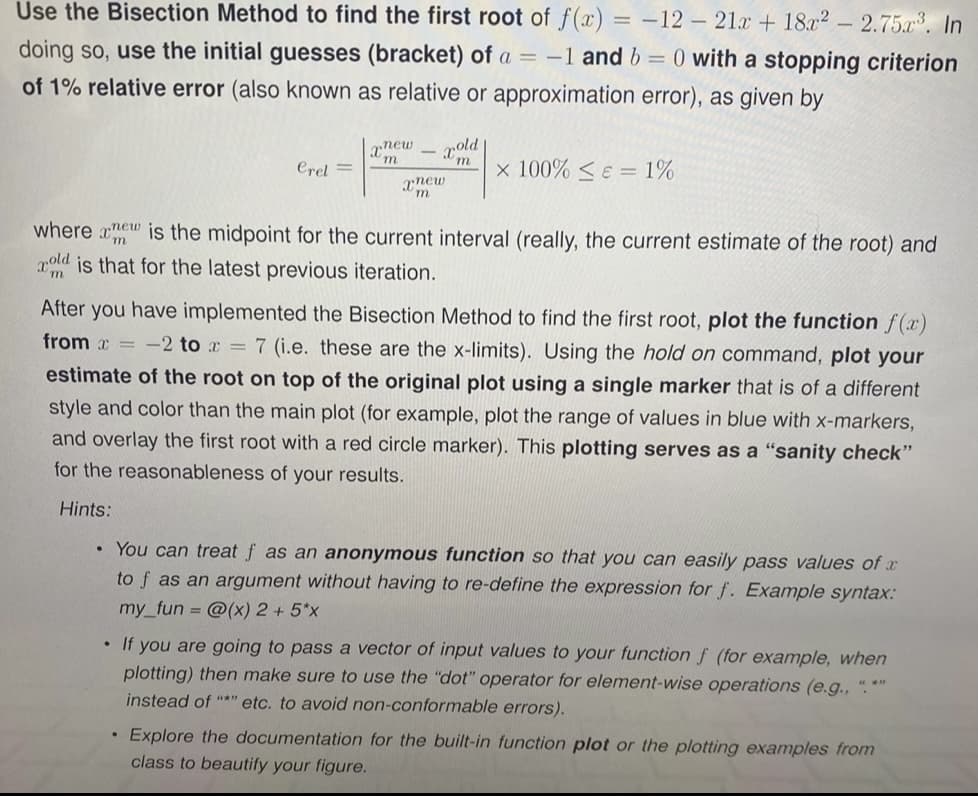Jse the Bisēčtión Method to find the first root of f(x) = -12 – 21x + 18x² -12 - 21a + 18x2 - 2.75³. In %3D doing so, use the initial guesses (bracket) of a = -1 and b= 0 with a stopping criterion of 1% relative error (also known as relative or approximation error), as given by %3D rold x 100%
Jse the Bisēčtión Method to find the first root of f(x) = -12 – 21x + 18x² -12 - 21a + 18x2 - 2.75³. In %3D doing so, use the initial guesses (bracket) of a = -1 and b= 0 with a stopping criterion of 1% relative error (also known as relative or approximation error), as given by %3D rold x 100%
Mathematics For Machine Technology
8th Edition
ISBN:9781337798310
Author:Peterson, John.
Publisher:Peterson, John.
Chapter87: An Introduction To G- And M-codes For Cnc Programming
Section: Chapter Questions
Problem 27A: Write a CNC G-code program to machine the part in the following figure, so that the tip of the tool...
Related questions
Question

Transcribed Image Text:xnew
Use the Bisection Method to find the first root of f(x) = -12 - 21c + 182 – 2.75.x°. In
doing so, use the initial guesses (bracket) of a = -1 and b = 0 with a stopping criterion
of 1% relative error (also known as relative or approximation error), as given by
xnew
pold
m,
Crel =
x 100% < e = 1%
where re is the midpoint for the current interval (really, the current estimate of the root) and
xold is that for the latest previous iteration.
After you have implemented the Bisection Method to find the first root, plot the function f (x)
from r = -2 to r = 7 (i.e. these are the x-limits). Using the hold on command, plot your
estimate of the root on top of the original plot using a single marker that is of a different
style and color than the main plot (for example, plot the range of values in blue with x-markers,
and overlay the first root with a red circle marker). This plotting serves as a "sanity check"
for the reasonableness of your results.
Hints:
• You can treat f as an anonymous function so that you can easily pass values of x
to f as an argument without having to re-define the expression for f. Example syntax:
my_fun = @(x) 2 + 5*x
• If you are going to pass a vector of input values to your function f (for example, when
plotting) then make sure to use the "dot" operator for element-wise operations (e.g., ".
instead of "**
etc. to avoid non-conformable errors).
• Explore the documentation for the built-in function plot or the plotting examples from
class to beautify your figure.
Expert Solution
This question has been solved!
Explore an expertly crafted, step-by-step solution for a thorough understanding of key concepts.
Step by step
Solved in 6 steps with 6 images

Recommended textbooks for you

Mathematics For Machine Technology
Advanced Math
ISBN:
9781337798310
Author:
Peterson, John.
Publisher:
Cengage Learning,

Algebra & Trigonometry with Analytic Geometry
Algebra
ISBN:
9781133382119
Author:
Swokowski
Publisher:
Cengage

Trigonometry (MindTap Course List)
Trigonometry
ISBN:
9781337278461
Author:
Ron Larson
Publisher:
Cengage Learning

Mathematics For Machine Technology
Advanced Math
ISBN:
9781337798310
Author:
Peterson, John.
Publisher:
Cengage Learning,

Algebra & Trigonometry with Analytic Geometry
Algebra
ISBN:
9781133382119
Author:
Swokowski
Publisher:
Cengage

Trigonometry (MindTap Course List)
Trigonometry
ISBN:
9781337278461
Author:
Ron Larson
Publisher:
Cengage Learning


College Algebra
Algebra
ISBN:
9781305115545
Author:
James Stewart, Lothar Redlin, Saleem Watson
Publisher:
Cengage Learning